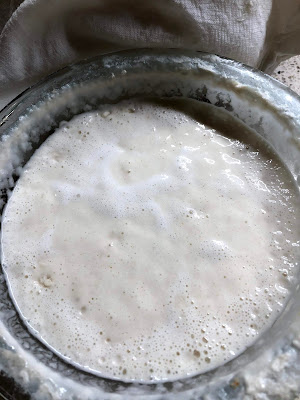So here's my third use of sourdough with the help of Beth Hensperger. I decided to try her rustic country bread. The recipe calls for wheat berries, which I actually HAVE! I bought them and used them for one of the rustic breads in the Tartine cookbook (another one that I love, but each bread takes two or three days).
This bread is also a three day bread that I shortened to two days because I used my levain instead of making hers. I started with 1 cup of my sourdough levain and added 1 1/2 cups of warm water and 2 cups of bread flour. The mixture was really wet and bubbly.
On Day Three (it really was my second day, but if you follow the recipe, this is Day Three), I think Beth left out a step. She says to stir down the sponge and add the "yeast mixture." She says to add 1 tsp active dry yeast. I've never used active dry yeast without dissolving it and she does say "yeast mixture" so I dissolved the tsp of yeast in 1/4 cup of water with the tiniest bit of honey to make the yeast happier. THEN I added the what-was-then-yeast-mixture to the sponge.
I drained the wheat berries (1/4 cup soaked in boiling water for FOUR hours - this bread takes all of the third day) and poured them over the yeast and sponge. Then added 1/3 cup of rye flour and a cup of bread flour. This whole combo is mixed well and then you add up to 2 1/2 cups of bread flour, 1/2 cup at a time. I only needed 2 cups, despite the 1/4 cup of yeast mix water.
After kneading this, my bread dough was left to rise for 2 - 2 1/2 hours. The little nubs poking out are the wheat berries. Well, I'm going to leave it and go take a coronavirus on-line chair yoga class.
Two and a half hours and a yoga class later, the risen dough looks like this:
I poured it out of the rising bowl and cut it into two parts. Then I shaped the two parts into smooth balls.
I let these sit on the counter for about five minutes and then placed them upside down in two bannetons.
Bottoms up! Here they are, ready to rise for another 1 1/2 hours. I baked each of them in my cloche. When I do that, I put the bread in the hot cloche at 500 degrees in the oven for 22- 25 minutes. Then I lower the temperature to 450. After 10 minutes at 450, I remove the cover of the cloche and let the loaf brown for another 10 minutes or so.
I just can't figure out the lame and snipped these with scissors - also didn't come out well. I'll bet the bread tastes great for tomorrow's toast, though!
This bread does not have big holes because it is kneaded hard and well. I don't think that was the goal of this bread. Having had it toasted for breakfast, it was delicious. My favorite of these three Beth Hensperger sourdough loaves is the Pain de Seigle, though, because of the caraway seeds.
















































